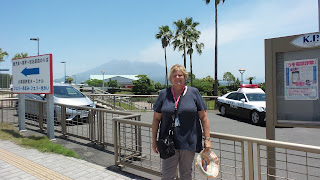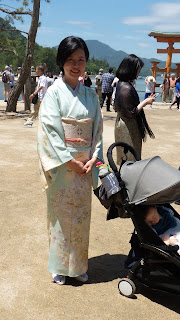More to Hiroshima than originally expected...
Before visiting all I knew Hiroshima was the first site of the Atom Bomb. I found Hiroshima a city of contrasts. Again we caught the ship's shuttle, today to the transport hub of Hiroden Itsukaichi Station. Here an information booth had been set up giving us transport, times and costs to travel to various points of interest. Our group of 7 decided to catch a street car (tram) to Miyajima Port and catch the ferry to the island off shore to see the Itsukushima Shrine and Tori Gate at its sea approach.
We got our directions wrong and ended up walking a distance to the tram stop before where we would have caught it! I wonder if someone had a joke at our expense when we asked someone as we were virtually in front of the tram stop!
The ferry to the island. There were oyster beds in the sea nearby.
Yen 190 Street car to island, Return ferry Yen 360, Shrine Y610. Street car to A Bomb site Y430.
Distant photo of O-Torii Gate and Shrine behind.
Itsukushima Shrine
A place of worship, one stage the whole island was worshiped like a God. the shine was erected to protect the place where the God resided. Paying homage of the shrine become popular among fishermen and tradesmen who sailed into the Seto Inland Sea and a main pilgrimage destination for people living in Western Japan. The blue sea in front, green forest behind and the vermilion of the shrine gives a peaceful appearance. It has been listed as a World Heritage Site. The O-Tor ii Gate was accessible by the low tide when we were there. It is the 8th to be rebuilt.
Entrance to site after disembarking from ferry.
Walkway with beach on right and mountainside on left.
The island is home to wild deer which seem to be fairly tolerant of people taking photos and sometimes peting.
Five Tiered Pagoda near the the shrine.
O-Torii Gate known as the 'floating Torii'
Statues line the walkway to the shrine
Whilst we were at the Torii Gate we saw a bride and groom in traditional dress. They were followed by what appears to be their parents who all wore black, walking behind the rickshaw.
This lovely lady politely posed for me to take her photo.
We stayed on the island to have lunch at one of the many cafes and food places before returning to the mainland then caught the streetcar to the A-Bomb Site in Hiroshima.
At the Hiroshima Peace Memorial (Atomic Bomb Dome).
Photo of the site 2 months after the terrible event.
View from the bridge which crosses to Peace Park
High School students at Children's Peace Monument. A memorial to the young lives lost to the atomic bomb. They had donated folded paper cranes, a symbol to the pursuit of peace. In the rear of the monument are glass show cases with thousands of paper cranes, some sent from not only Japanese schools but from schools throughout the world.
Flame of Peace will continue to burn until nuclear weapons are abolished world wide.
Cenotaph for Atomic's Victims holds more than 290,000 names of those who lost their lives to the bomb.





























































